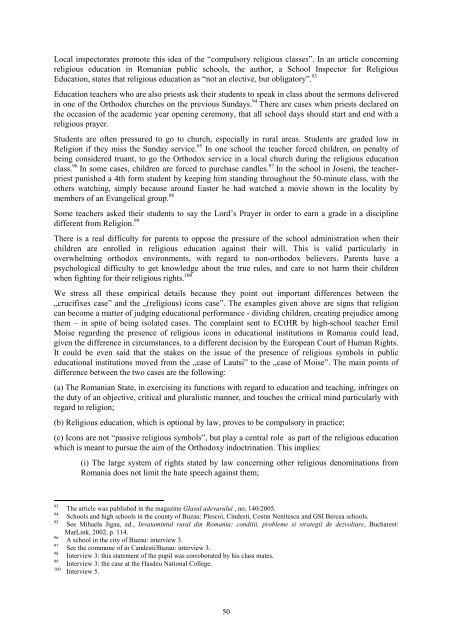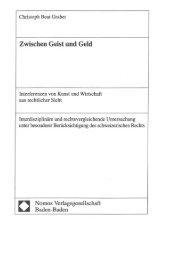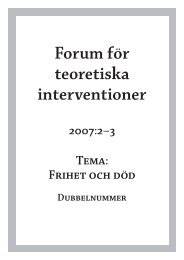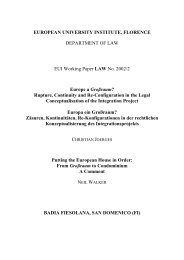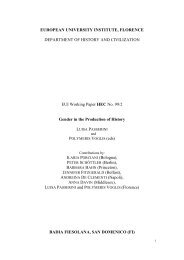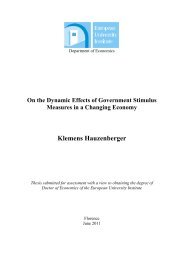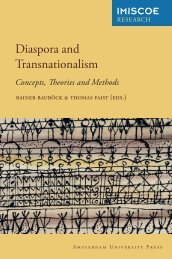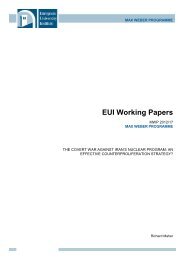Sinziana-Elena Poiana Ioana Lupea Irina-Madalina Doroftei Alina ...
Sinziana-Elena Poiana Ioana Lupea Irina-Madalina Doroftei Alina ...
Sinziana-Elena Poiana Ioana Lupea Irina-Madalina Doroftei Alina ...
You also want an ePaper? Increase the reach of your titles
YUMPU automatically turns print PDFs into web optimized ePapers that Google loves.
Local inspectorates promote this idea of the “compulsory religious classes”. In an article concerning<br />
religious education in Romanian public schools, the author, a School Inspector for Religious<br />
Education, states that religious education as “not an elective, but obligatory”. 93<br />
Education teachers who are also priests ask their students to speak in class about the sermons delivered<br />
in one of the Orthodox churches on the previous Sundays. 94 There are cases when priests declared on<br />
the occasion of the academic year opening ceremony, that all school days should start and end with a<br />
religious prayer.<br />
Students are often pressured to go to church, especially in rural areas. Students are graded low in<br />
Religion if they miss the Sunday service. 95 In one school the teacher forced children, on penalty of<br />
being considered truant, to go the Orthodox service in a local church during the religious education<br />
class. 96 In some cases, children are forced to purchase candles. 97 In the school in Joseni, the teacherpriest<br />
punished a 4th form student by keeping him standing throughout the 50-minute class, with the<br />
others watching, simply because around Easter he had watched a movie shown in the locality by<br />
members of an Evangelical group. 98<br />
Some teachers asked their students to say the Lord’s Prayer in order to earn a grade in a discipline<br />
different from Religion. 99<br />
There is a real difficulty for parents to oppose the pressure of the school administration when their<br />
children are enrolled in religious education against their will. This is valid particularly in<br />
overwhelming orthodox environments, with regard to non-orthodox believers. Parents have a<br />
psychological difficulty to get knowledge about the true rules, and care to not harm their children<br />
when fighting for their religious rights. 100<br />
We stress all these empirical details because they point out important differences between the<br />
„crucifixes case” and the „(religious) icons case”. The examples given above are signs that religion<br />
can become a matter of judging educational performance - dividing children, creating prejudice among<br />
them – in spite of being isolated cases. The complaint sent to ECtHR by high-school teacher Emil<br />
Moise regarding the presence of religious icons in educational institutions in Romania could lead,<br />
given the difference in circumstances, to a different decision by the European Court of Human Rights.<br />
It could be even said that the stakes on the issue of the presence of religious symbols in public<br />
educational institutions moved from the „case of Lautsi” to the „case of Moise”. The main points of<br />
difference between the two cases are the following:<br />
(a) The Romanian State, in exercising its functions with regard to education and teaching, infringes on<br />
the duty of an objective, critical and pluralistic manner, and touches the critical mind particularly with<br />
regard to religion;<br />
(b) Religious education, which is optional by law, proves to be compulsory in practice;<br />
(c) Icons are not “passive religious symbols”, but play a central role as part of the religious education<br />
which is meant to pursue the aim of the Orthodoxy indoctrination. This implies:<br />
(i) The large system of rights stated by law concerning other religious denominations from<br />
Romania does not limit the hate speech against them;<br />
93<br />
The article was published in the magazine Glasul adevarului , no. 140/2005.<br />
94<br />
Schools and high schools in the county of Buzau: Plescoi, Cindesti, Costin Nenitescu and GSI Bercea schools.<br />
95<br />
See Mihaela Jigau, ed., Invatamintul rural din Romania: conditii, probleme si strategii de dezvoltare, Bucharest:<br />
MarLink, 2002, p. 114.<br />
96<br />
A school in the city of Buzau: interview 3.<br />
97<br />
See the commune of in Candesti/Buzau: interview 3.<br />
98<br />
Interview 3: this statement of the pupil was corroborated by his class mates.<br />
99<br />
Interview 3: the case at the Hasdeu National College.<br />
100 Interview 5.<br />
50


